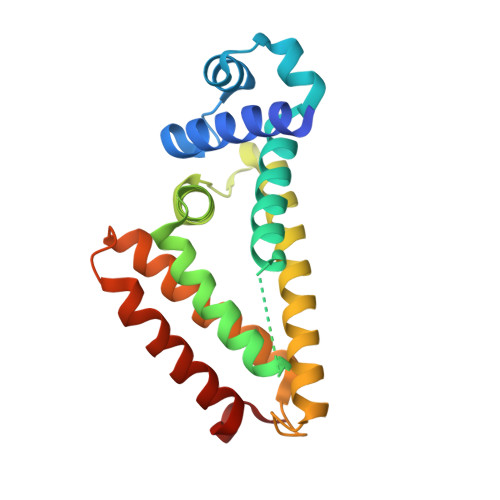Structural, Biochemical, and In Vivo Characterization of MtrR-Mediated Resistance to Innate Antimicrobials by the Human Pathogen Neisseria gonorrhoeae .
Beggs, G.A., Zalucki, Y.M., Brown, N.G., Rastegari, S., Phillips, R.K., Palzkill, T., Shafer, W.M., Kumaraswami, M., Brennan, R.G.(2019) J Bacteriol 201
- PubMed: 31331979
- DOI: https://doi.org/10.1128/JB.00401-19
- Primary Citation of Related Structures:
6OF0 - PubMed Abstract:
Neisseria gonorrhoeae responds to host-derived antimicrobials by inducing the expression of the mtrCDE -encoded multidrug efflux pump, which expels microbicides, such as bile salts, fatty acids, and multiple extrinsically administered drugs, from the cell. In the absence of these cytotoxins, the TetR family member MtrR represses the mtrCDE genes. Although antimicrobial-dependent derepression of mtrCDE is clear, the physiological inducers of MtrR are unknown. Here, we report the crystal structure of an induced form of MtrR. In the binding pocket of MtrR, we observed electron density that we hypothesized was N -cyclohexyl-3-aminopropanesulfonic acid (CAPS), a component of the crystallization reagent. Using the MtrR-CAPS structure as an inducer-bound template, we hypothesized that bile salts, which bear significant chemical resemblance to CAPS, are physiologically relevant inducers. Indeed, characterization of MtrR-chenodeoxycholate and MtrR-taurodeoxycholate interactions, both in vitro and in vivo , revealed that these bile salts, but not glyocholate or taurocholate, bind MtrR tightly and can act as bona fide inducers. Furthermore, two residues, W136 and R176, were shown to be important in binding chenodeoxycholate but not taurodeoxycholate, suggesting different binding modes of the bile salts. These data provide insight into a crucial mechanism utilized by the pathogen to overcome innate human defenses. IMPORTANCE Neisseria gonorrhoeae causes a significant disease burden worldwide, and a meteoric rise in its multidrug resistance has reduced the efficacy of antibiotics previously or currently approved for therapy of gonorrheal infections. The multidrug efflux pump MtrCDE transports multiple drugs and host-derived antimicrobials from the bacterial cell and confers survival advantage on the pathogen within the host. Transcription of the pump is repressed by MtrR but relieved by the cytosolic influx of antimicrobials. Here, we describe the structure of induced MtrR and use this structure to identify bile salts as physiological inducers of MtrR. These findings provide a mechanistic basis for antimicrobial sensing and gonococcal protection by MtrR through the derepression of mtrCDE expression after exposure to intrinsic and clinically applied antimicrobials.
Organizational Affiliation:
Department of Biochemistry, Duke University School of Medicine, Durham, North Carolina, USA.














